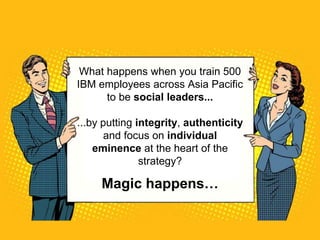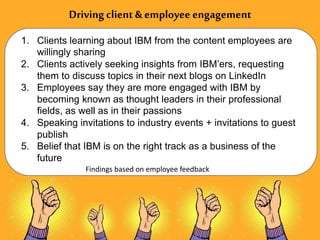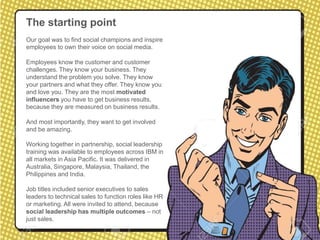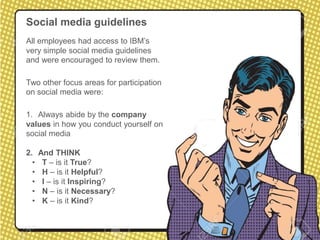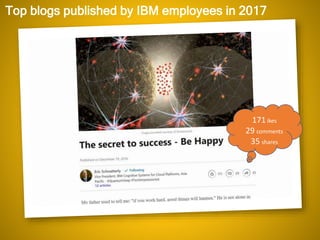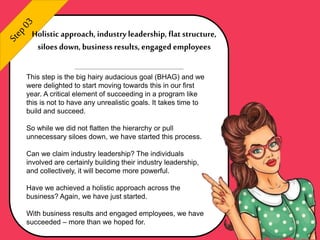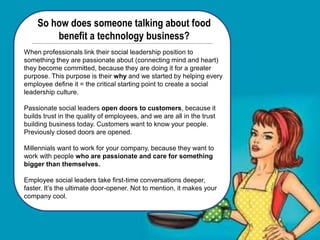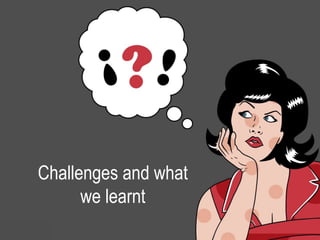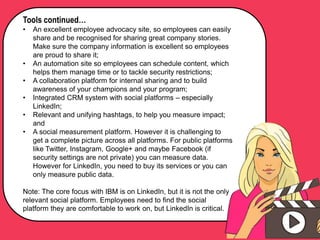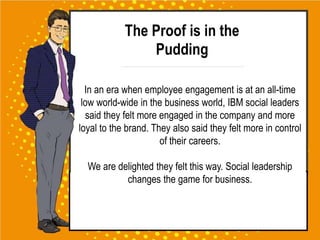Success Story - UNLEASH your employees, DISRUPT from within, GROW your business
- 1. Success Story UNLEASH your employees DISRUPT from within GROW your business Social leadership delivers business results, drives employee engagement andbuilds trust IBM CognitiveSystemsforCloudAsiaPacific andThe DigitalConversationalist
- 2. What happens when you train 500 IBM employees across Asia Pacific to be social leaders... ...by putting integrity, authenticity and focus on individual eminence at the heart of the strategy? Magic happens…
- 3. You’ll learn… the secret sauce • RESULTS? We know it works • WHY? The challenge addressed • WHAT? Getting advocacy right • HOW? The approach
- 4. Measuring social success Measuring ROI for social media activity is challenging. Employees own their “data” on LinkedIn and engage across multiple social media and blogging platforms. Our approach to measure success was through surveying individuals post- training, who demonstrated active involvement on social media over a period of time. These socially active individuals are engaging intelligently, sharing thought leadership content aligned to their professional passion, connecting with the right people, and/or creating their own content. Results
- 5. US$81 million These results are conservative and are based on self-reported feedback from IBM's most active social leaders. Based on feedback from less than 10 active individuals, we established a direct correlation between social activity and customer wins and pipeline. Wins US$24 million Pipeline US$57+ million The results so far… Customer wins & pipeline
- 6. Some numbers from LinkedIn blogs 500+ employees trained across APAC 26 workshops 121+ coaching 124 blogs published on LinkedIn by employees Blog responses 5,337++ which is people engaging publicly with blogs – comments, likes, shares Estimated potential exposure for bloggers based on readers actions? 2.7 million and beyond
- 7. Who does your audience trust… Who has more social clout & motivation… Who brings leads… Results… 15% of consumers trust company posts on social media 49% of consumers trust regular employees 77% of consumers will purchase after hearing from someone they trust 67% of engaged employees say they actively advocate for their company 10x More connections of your employees vs your company followers 78% of engaged employees would recommend their company’s product 5x Increase in web traffic from employee social 25% Increase in leads from employee social 7x More frequent conversion of leads 8x Increase in share rate of content by employees vs by the brand 30% Increase in engagement with content 20x Increase in revenue & operating income Why does it work? Because it’s all about trust
- 8. Drivingbusinessresults 1. Significant business wins/pipeline 2. Opened previously closed doors to prospects 3. New partnerships and alliances 4. Growing belief in the effectiveness of strategic social selling 5. Bigger networks globally, opening doors to opportunities for IBM and its employees 6. Social networks are more engaged with IBM employees who have eminence 7. Deeper relationships with existing customers Findings based on employee feedback
- 9. Drivingclient &employee engagement 1. Clients learning about IBM from the content employees are willingly sharing 2. Clients actively seeking insights from IBM’ers, requesting them to discuss topics in their next blogs on LinkedIn 3. Employees say they are more engaged with IBM by becoming known as thought leaders in their professional fields, as well as in their passions 4. Speaking invitations to industry events + invitations to guest publish 5. Belief that IBM is on the right track as a business of the future Findings based on employee feedback
- 10. Drivingclient &employeeengagement 1. Growing self-confidence and belief they are in control of their careers 2. Employees are learning more as they create content and actively seek world-class content to share with their networks 3. Employees are more confident in growing their networks across social media, providing more access to key decision makers 4. Increased internal visibility within IBM, which increases confidence in future opportunities 5. More loyalty to IBM Findings based on employee feedback
- 11. Content marketing efforts generate 3x as many leads as traditional marketing, and costs 62% less Demand Metric Challenges Traditional marketing activities are no longer delivering results that companies, such as IBM, want to achieve. Brands are also struggling to effectively engage employees to actively take part on social media. At the same time, marketing and sales teams are often experiencing frustration with each other. Marketing isn’t delivering content that effectively supports sales leaders; who in turn aren't providing insights that marketing need for content development. At IBM, the leadership team are addressing these challenges, by engaging employees to become a content creation army, believing that the value of the organization lies with their people. The question becomes: how can we help the individual team members discover and own their passion ? How do we motivate them to demonstrate their best to their digital community? This in turn will elevate the best of IBM – its employees - to its clients and markets. Building a social leadership culture can help reduce silo friction by making everyone responsible for building customer trust, inspiring employees to be more externally focused, and building more internal unity focused on delighting the customer.
- 13. Employee advocacy Employee advocacy is becoming a strategic imperative for senior leadership teams. Acknowledging that employees are individually and uniquely powerful on social media – as influencers in their own right – will be deemed a strategic asset, especially in the B2B space. The collective power and potential impact of active and intelligently engaged employees is now understood, as research indicates the most trusted resource within any business are its people. However, historically, businesses have only focused on elevating the most senior people, in a controlled and measured way. That time is over. The fundamental shift – due to social media - is to employee voices, not brands. But to make an impact and be heard, individual credibility is paramount. Senior leadership teams expecting employees to become megaphones for the brand run the risk of failure, hurting both brand and employee reputations. Getting employee advocacy right
- 14. Employee advocacy The challenge? Employee advocacy is often positioned as a one-sided affair – to benefit the brand. However, digitally-savvy employees – the ones you want representing your company – won’t buy into this because they understand and value the power of their own social leadership position. Employees say they resent this expectation, because it lacks integrity, is insincere and they would rather do nothing than participate this way. Leaders who get employee advocacy right, understand they must inspire employees to own their voice, become social leaders, support them and celebrate the champions. Championing employees, across every level of the organization, and supporting them for the long- term, is a game changer. When leaders understand this opportunity, they bask in the glow of powerful employee brands, enjoying higher employee engagement, attracting and retaining the best people, gaining customer and employee trust, new customers, business wins, partnerships and more. It’s completely transformational for employees and business.
- 15. Top business blog published by IBM employee 263 likes 5 comments 30 shares
- 16. Transforms IBM’s voice to one of "technical expert" Drives 10x engagement on posts versus IBM brand posts Drives 8x engagement when pushing posts to brand assets versus paid media Engages with locally matched influencers – participating in influencer forums and hosting VIPs Client ambassador Co-owns MeetUps as teacher and expert; Speaks at various internal and external industry events; Gains access to new accounts and clients. Content creator All Star LinkedIn profile & Pulse blog; Shares expertise in various technical and industry communities; Co-creates content with marketing team. Imagine a team of Gerard's… Gerard Suren Saverimuth Cognitivesolutionsellingleader,cloud evangelist, cricketer,hobbyistphotographerwithzestoflife
- 17. NishanWeerasinghe, Director of Marketing, IBM Cognitive Systems for CloudAsia Pacific “Before we started, I had poked around social engagement for some time. Knowing that it was the right thing, but I couldn’t see a way to scale it across my business. I also knew I could utilize these tools better personally. “At the time, I was hearing a lot of push back and cynicism from colleagues – all of which made perfect sense to me. There was a LOT of nonsense on social media, and it continues to this day. “This approach addressed those concerns. It was about getting employees focused on whatever area they cared most about – tying in personal passion – and then it offered structure, so employees had a place to start and most importantly, it was from a place of personal integrity. That was the critical piece for me. “No employee wants to be a mouthpiece for a brand – no matter how much they love working for a company. Helping employees identify what they want to be known for and then owning that voice as a first priority, with IBM benefiting off the back of this, it completely matched my belief that we could unleash our employees, and they would handle themselves with integrity, attracting customers, talent, partnerships, and be more engaged themselves. “This has been borne out time and again since we started this program, and I couldn’t be more delighted with the results we are seeing, right across the board, from customer wins to more engaged employees. It’s been inspiring to be part of this change for IBM in Asia Pacific”
- 18. The approach
- 19. To inspire employees to become leaders on social media. With integrity and a service mindset being a core tenet of participation, employees are empowered to represent themselves first and IBM second, with the goal to create an army of brand ambassadors and content creators in their own right. Goal
- 20. Top blog aligned with a personal message 450 likes 101 comments 9 shares
- 21. The starting point Our goal was to find social champions and inspire employees to own their voice on social media. Employees know the customer and customer challenges. They know your business. They understand the problem you solve. They know your partners and what they offer. They know you and love you. They are the most motivated influencers you have to get business results, because they are measured on business results. And most importantly, they want to get involved and be amazing. Working together in partnership, social leadership training was available to employees across IBM in all markets in Asia Pacific. It was delivered in Australia, Singapore, Malaysia, Thailand, the Philippines and India. Job titles included senior executives to sales leaders to technical sales to function roles like HR or marketing. All were invited to attend, because social leadership has multiple outcomes – not just sales.
- 22. Social media guidelines All employees had access to IBM’s very simple social media guidelines and were encouraged to review them. Two other focus areas for participation on social media were: 1. Always abide by the company values in how you conduct yourself on social media 2. And THINK • T – is it True? • H – is it Helpful? • I – is it Inspiring? • N – is it Necessary? • K – is it Kind?
- 23. The team Nishan Weerasinghe, CMO, IBM Cognitive Systems for Cloud Asia Pacific Tara Moody, Portfolio Marketing and Influencer Strategy, IBM Cognitive Systems for Cloud Asia Pacific Sunny Panjabi, Marketing Manager, Content & Social, IBM Cognitive Systems for Cloud Asia Pacific Andrea Edwards, Founder and CEO, The Digital Conversationalist
- 24. Starting with the right mindset The most important starting point - to encourage employees to become social leaders - is the right mindset. To build a strong, powerful and impactful social leadership position, it’s quite simply about everyone being world-class. It’s about being of service to your audience for each of your social leaders. It’s about sharing information that is going to transform people you want to transform. It’s about creating, finding and sharing the best knowledge you can and getting it in front of the right people who will benefit enormously by reading or watching it. To lead, brands must empower employees to own their voice, and employees must be focused on a topic that is relevant to them personally and aligned to their ambitions or dreams. When professionals participate in a focused way, this is how they become thought leaders – which should be the purpose of being present in the first place. Focus, passion, intent and a mindset of service is the key to success.
- 25. Top blogs published by IBM employees in 2017 171ikes 29 comments 35 shares
- 26. Through my social leadership activity, clients that had “closed doors” to IBM have opened them. They are learning about IBM solutions from what I’m sharing on LinkedIn and senior decision makers have been reaching out to me directly on LinkedIn to discuss how IBM can help them. We have moved rapidly towards a sale from this initial outreach, and today I am privileged to work with my clients as a trusted strategic advisor on their technology strategy. It’s been incredible and it all started based on how I was participating on LinkedIn: social leadership with a mindset of delivering value, being consistent and serving customers is the cutting edge of sales today. I’m committed. PaulJamieson IBM cognitive infrastructure sales – Telstra account, Australia Eric Schnatterly Vice President, IBMcognitive system for cloud platforms,Asia Pacific I have used social media to make connections and progress opportunities and close deals. I continue to use social selling to make new network connections, resulting in increased business development and new pipeline. Examples include new opportunities with MSP's and AI start-ups, as well as mutual opportunities with IBM Alliance partners.
- 27. The 3-Step Journey to Social Leadership Get Started Empower the employees Drive Leads, Grow Business Launch Train Coach leaders Inspire Support Motivate Amplify work Recognize stars Holistic approach Industry leadership Flat structure, siloes down Business results, engaged employees Step 01 Step 02 Step 03
- 28. In the first year, we focused on Step 01, with the main goal of the training to inspire employees to embrace this opportunity and own their voice. The training offered both structure and freedom. We found that 30 per cent embraced the opportunity immediately and made it a priority, even when all are time-challenged. We helped employees find their focus, a starting point, and most importantly, inspired them to do the work themselves. When an employee is inspired to be a social leader, they do not want to outsource their voice. Launch,train,coach, inspire
- 29. Summary of the program • Full or half day training and 1-on-1 coaching – Australia, Malaysia, Thailand, India, Philippines and Singapore. • Open discussion around the broader content and social media landscape – beyond IBM and technology – including tackling cynicism. • Defining what each employee wants to be known for – identifying their eminence. • Updating social media profiles – with a focus on LinkedIn. • Getting started on social media professionally. • Introduction to video and blogging, discussions on relevance across all social media platforms. • 1-on-1 coaching and support following training. • Celebrating the champions internally.
- 30. A program like this will attract cynicism internally and externally until its value is proven. We always faced it upfront and started training with the question: Who is cynical about social media and taking a social leadership position? Every time, there were cynics. Two reasons consistently emerged: One: there is already so much noise; how can I possibly do anything of value that is not just adding to it? A beautiful, perfect question and one valued above all others, because it demonstrates a level of thought that to be present, you have to deliver value. There’s enough noise. We all know it and it’s getting louder every day. We loved hearing IBM professionals appreciating this. It is the right place to start and the right question to ask. Tackling cynicism honestly
- 31. First: we must all stop doing things that no longer serve us or our company. We continue because everyone knows how to do it and the company knows how to measure it. Individually, and as teams, we need to take a step back and ask: what no longer serves us? What isn’t getting us the results we need? And where can we get those results today? Second: identifying where to start. There are many tips and tricks to help employees be efficient, and the most important message is that no professional has to spend an enormous amount of time to be present and engaged on social media. Once focused, we recommended all employees make a commitment to share two articles a week that are aligned to what they want to be known for. The only rule is that the content has to be so excellent that by sharing it, it adds to their eminence in the field they want to be known for. Once in a rhythm, employees start to become trusted contacts that share awesome information! Two: it takes so much time, how do I fit itin? Tackling cynicism honestly
- 32. Top blogs published by IBM employees in 2017 166 likes 30 comments 155 shares
- 33. KateMorphett Client Manager, IBMDigital Business Group ChristianRaetzsch Vice President, CTO,IBM,Asia Pacific “My network has more than doubled, with reach beyond Singapore and AP into Europe, Central Eastern Europe, Russia, Africa, US. Head-hunters are reaching out to me. Visibility and reach as a professional, a strong personal brand that translates into personal "value" as a subject matter expert (... personal growth and compensation...). This is more important than ever, in a vibrant, dynamic and very disruptive world, where mediocrity and standard jobs will increasingly be covered by smart systems and machines (applied artificial intelligence).” “We should take "building a personal brand" seriously and feed the content of IBM into social channels because that is how we reach customers. If everyone's message reaches influencers or clients, those messages should be considered a key part in how we sell. “I was impressed when a client called me and said: "I saw the article you posted from IBM about Robotics Process Automation. We are interested, can you bring the team to present to us?" It is a good to start to the year 2018 when a client calls and asks this.”
- 34. The starting steps we defined One requested task: share one piece of company content a week (if possible), because employees benefit by the association with IBM and vice versa. By sharing company content, IBM benefits, experiences the results of employee advocacy, and starts to support employees. But employees were only encouraged to share company content they love. This is their profile, not the companies, and we must always be proud of what we share. Engage with your community on social media 1 2 3 Define your focus Make a commitment to sharing content aligned to that focus
- 35. All enterprises are overwhelmed with information channels and it is challenging to break through the clutter to get attention on social leaders. We identified two areas for success. Excellent internal communication channels, so employees can share their work internally and have it supported by colleagues. We also focused on delivering a monthly newsletter, to celebrate successes, share positive feedback, showcase blogs published, and motivate others to seize this opportunity. We kept the momentum going, long after the training and coaching. Support, motivate, amplify work & recognize stars
- 36. The most important part of this training, was the focus on the #GivingEconomy. It's the "secret sauce" of the program as a way to motivate employees to "own" their own voice. How does it work? Many believe social leadership is a tool to push views. It’s perceived as narcissistic, a place to show off, and it’s all about “me”. The majority of professionals do not like this aspect of social media. The Giving Economy mindset changes this thinking. The idea is you will be more successful and build a more powerful social leadership position, if you spend most of your time helping others succeed. There are many ways to do this, including: sharing colleagues' awesome content; engaging in colleagues' posts on social media; publicly praising team members for a job well done; writing references/endorsing skills and more. To be a leader on social media, the greatest focus must be on helping others win, and in return, you win too. The Giving Economy was a central tenet of the social leadership training, fully embraced by IBM employees, and is the most powerful and effective way for anyone to build their eminence – especially for leaders of businesses – because it motivates and inspires employees to stay on task and keep building their social leadership position. A 'Giving Economy' mindset
- 37. “The Giving Economy message definitely resonated with me deeply and was the core vision of this program that convinced me to be a committed social leader. Before I thought of social leadership this way, having a presence on social media always felt selfish or narcissistic. The idea that you succeeded by helping others succeed, yes, that was something I could passionately get behind, and I am delighted that we have 500 IBM Ambassadors in Asia Pacific with this mindset. “Being a social leader is a very meaningful part of my professional life today, and to be part of the pioneering team at IBM in Asia Pacific that got this off the ground – and trust me, it hasn’t been easy – is one of my greatest career journeys to date. I can’t wait to see what we do next, all with this mindset of service at the core. It’s exciting.” Tara Moody, Portfoliomarketing andinfluencer strategy, IBMCognitive Systems for CloudAsia Pacific
- 38. This step is the big hairy audacious goal (BHAG) and we were delighted to start moving towards this in our first year. A critical element of succeeding in a program like this is not to have any unrealistic goals. It takes time to build and succeed. So while we did not flatten the hierarchy or pull unnecessary siloes down, we have started this process. Can we claim industry leadership? The individuals involved are certainly building their industry leadership, and collectively, it will become more powerful. Have we achieved a holistic approach across the business? Again, we have just started. With business results and engaged employees, we have succeeded – more than we hoped for. Holistic approach, industryleadership, flat structure, siloes down, businessresults, engaged employees
- 39. Top blogs published by IBM employees in 2017 108 likes 48 comments 14 shares
- 40. Deepthi Anne Technology Solution Advisor SinisaNikolic Director Systems for cloud andCognitiveplatforms at IBM I have reconnected with previous clients and that has allowed IBM to engage and be invited to meetings. This is goodness, and we are yet to count the $$ on that impact. I have also had a couple of interesting client meetings where they said it was very nice to meet me as they have read my blogs. That was a very nice interaction. “Writing blogs has changed the way my customers look at me. More than a seller, they now view me as a technology advisor.”
- 42. 20% 20% 30% 30% Leadership Mentorship Foodie, lifestyle, mindfulness Customer Issues Roles HR, marketing A broad look at topics IBM employees wanted to be eminent in
- 43. Customer issues 30% of senior executives/sales/BDMs seek to talk about the customer issues they are hearing about every day and help customers solve them Leadership 20% seek to inspire and talk about leadership or mentoring the next generation Job functions 30% are in job functions and they want to be eminent about their role and what they’re learning/how they’re evolving/disruption relevant to their job function (e.g. HR, finance, marketing) Personal passion 20% are lifestyle or foodie bloggers, into health and wellness, mindfulness, spirituality, etc Drilling down into eminence
- 44. What does it deliver IBM? Category 1 – Customer issues, critical for marketing to champion. They are speaking directly to customer issues from a place of experience and empathy. They are an asset to any business. Category 2 – a leadership/mentorship focus attracts great talent and inspires employees. With 50 per cent of the workforce set to be millennials by 2020 (and millennials caring most about company culture) these voices give that insight. Category 3 – job function leaders are critical. By taking an industry stance in their own right, they position your company as an industry leader who hires industry thought-leaders within job functions. They attract the best talent in their field. They revolutionize their field. Category 4 – passion focus is often disparaged, because many struggle to understand how it matters… They make your company cool. It says your company is digitally savvy. They open doors to customers. Your company empowers your people. It positions your company as a business of the future. You company cares about the whole person.
- 45. So how does someone talking about food benefit a technology business? When professionals link their social leadership position to something they are passionate about (connecting mind and heart) they become committed, because they are doing it for a greater purpose. This purpose is their why and we started by helping every employee define it = the critical starting point to create a social leadership culture. Passionate social leaders open doors to customers, because it builds trust in the quality of employees, and we are all in the trust building business today. Customers want to know your people. Previously closed doors are opened. Millennials want to work for your company, because they want to work with people who are passionate and care for something bigger than themselves. Employee social leaders take first-time conversations deeper, faster. It’s the ultimate door-opener. Not to mention, it makes your company cool.
- 46. Shamini Prithivi Raj Helping public sector clients in Malaysia achieve their technology goals Marco Leoncelli Complex Solutions Lead – Global Financial Markets “I am a foodie blogger and since the training, it has been very welcoming and a lot of acceptance so far. Previously, IBM colleagues did not value my personal branding so much and did not feel that it is important.” “I genuinely feel my presence in the social media world and professional community has been enhanced following The Digital Conversationalist coaching and IBM’s investment.”
- 47. Top blogs published by IBM employees in 2017 19 likes 14 comments 6 shares
- 49. “It has been a huge privilege to be involved with this team, driving social leadership for IBM across Asia Pacific. I have personally learned and gained so much from my own social leadership position, but to watch people come out inspired and taking action, then seeing the results, has been amazing. “We took a chance when we started this, however we all understood and believed it would be a breakthrough initiative for the business, so I am really happy it has borne so much fruit. We couldn’t know what to expect. There is no example coming before to reference, so I am proud that we can be that reference for IBM and the business world”. Sunny Panjabi, Marketing Manager, Content & Social, IBM Cognitive Systems for Cloud Asia Pacific
- 50. Have you secured any speaking opportunities?
- 51. Social selling muscles When looking to build social selling muscles in sales teams, it’s all about inspiring sales leaders to be actively engaged and leading on social, so they earn the right to open doors to customers, because they are consistently delivering value to their community. This is "the in" with customers today. IBM’s social leaders are now being invited to partner with customers to help them define their technology strategy. All directly linked to their social media activities.
- 52. Top blogs published by IBM employees in 2017 88 likes 11 comments 29 shares
- 53. Challenges and what we learnt
- 54. 1. Securing leadership support from the start is critical - the digital revolution starts at the top, and they give permission to employees by becoming social leaders themselves. 2. Set realistic expectations. Employees will embrace it over time, but initially, participation rates will be around 25 to 30%. The biggest challenge is self confidence and making it a priority. 3. It’s hard work for the team driving it – especially at the beginning before success can be demonstrated. 4. Getting people to commit time to attend the training can be very challenging, especially sales staff. 5. After the training, you need ongoing communication and a team available to provide advice/coaching, as well as a supportive culture that celebrates successes and learns together – no one person can know everything social, so this sharing and learning is vital. 6. As the wins and successes come, it’s important to share with leadership teams and to celebrate the champions. 7. Internal recognition of social leadership as something of value versus being seen as unnecessary or a “time waster” is critical. 8. Building social leadership into the ethos of what it means to be an employee is a huge change management initiative. 9. Management support is critical for employees committed to building their personal brands. Employees want encouragement and recognition. LessonsLearned
- 55. Shalaka Verma Asia Pacific Technical Leader – Storage and Software Defined Solution at IBM “Social leadership is important because technology is best acquired via reference, references OR opinions of people with a personal brand count. I have experienced that even though my pitch is the same, people who have gone through my blog, even on unrelated subjects, tend to listen more attentively than a completely disconnected audience. “I happen to get lot of queries on the blog OR because I am known to be knowledgeable in a domain. “Personally, this journey has been rewarding. I have realized that commitment to writing makes you a committed learner. So this year I have written, but more importantly, I have read and learned a lot. “I think social leadership was always important, the sphere of influence is what has expanded. Earlier, you would communicate with your colleagues, managers, direct reports, OR maybe with industry colleagues, whom you come in contact with during the course of your work. Your credibility with them mattered to achieve the intended outcomes. “But now there is a means and possibility of connecting with people with whom you may not be dealing directly for your work. Nonetheless, your credibility with those people influences your ability to drive the outcomes in your immediate influence. So taking advantage of platforms to connect with an expanded sphere of influence is essential for technical professionals, especially the leaders and game changers.”
- 56. Tools, tips & technology to help employees succeed
- 57. Tools needed to support a social leadership culture? This is an ideal list and it’s important to start with what you have right now, and grow as the culture and demand grows. We recommend: • Access to a world-class image library; • Design support for content design, infographic creation, etc; • Video creation and editing support; • Website and blogging platform support for employees serious about blogging; • SEO support and training, design classes, video creation training, etc; • Professional writing support – some people have great ideas, but can’t capture them; • Professional editing support; and • A company showcase site to feature the content created by your employees – recommend a customer-relevant content site and a ‘your people’ site, which is perfect for HR/recruitment, as it provides access to company culture.
- 58. Tools continued… • An excellent employee advocacy site, so employees can easily share and be recognised for sharing great company stories. Make sure the company information is excellent so employees are proud to share it; • An automation site so employees can schedule content, which helps them manage time or to tackle security restrictions; • A collaboration platform for internal sharing and to build awareness of your champions and your program; • Integrated CRM system with social platforms – especially LinkedIn; • Relevant and unifying hashtags, to help you measure impact; and • A social measurement platform. However it is challenging to get a complete picture across all platforms. For public platforms like Twitter, Instagram, Google+ and maybe Facebook (if security settings are not private) you can measure data. However for LinkedIn, you need to buy its services or you can only measure public data. Note: The core focus with IBM is on LinkedIn, but it is not the only relevant social platform. Employees need to find the social platform they are comfortable to work on, but LinkedIn is critical.
- 59. Top blogs published by IBM employees in 2017 52 likes 36 comments 7 shares
- 60. Two final important take-aways 1 LinkedIn solves a huge content hurdle for regional teams Employees can easily publish content – both written and video – on LinkedIn. In fact, the content opportunity is LinkedIn's greatest asset - because it helps professionals overcome corporate obstacles to getting their voice heard. However, if you decide to make LinkedIn a primary focus for social leadership, you must invest in it. You will need LinkedIn Navigator for sales, leadership, marketing and social leaders and Premium for everyone else. You should also consider LinkedIn Elevate to amplify company content and employee content, as well as to measure results. Additionally, you can open Elevate up to your business ecosystem – partners, agencies, and more… However, employees will engage on the social media platforms they are comfortable with. This means you need to be in a position to see, support and measure it all. In Asia, there are many social media platforms specific to countries. Facebook is a professional powerhouse in the Philippines, Indonesia and Thailand. WeChat in China, etc.. One-size does not fit all.
- 61. Two final important take-aways 2 Get set up for employee feedback and sharing Encourage employees to share what’s working, what’s not, what new social platforms are available, and how to use them. No one person has the full perspective on all opportunities available, because there are so many different social media platforms. There is also no ‘one-way’ to be successful. Some are professional and educational, others funny or inspiring, and some are cheerleaders. There is value across all successful styles. They magic is authentic participation. Look for your SnapChat or Line champions, or someone achieving great business results from using WhatsApp intelligently, or even MeetUp Groups success. The creativity of someone passionate about a particular social media channel should not be underestimated. There’s so much value in internal experience, so ensure your micro-experts share to help others grow. Just this would be completely transformational!!
- 62. Jaswinder Singh Saini Managing Consultant for Storage & Hybrid Cloud (AWS) at IBM Systems Lab Services • Clients regularly check my links, blogs and technical videos and share their inputs • People have connected with me after going through my posts to share their queries • I have received calls from Clients and EX-IBMers appreciating the details shared and how it helped them • I am working on a white paper for IBM Storage Systems and its now part of my annual KRA • Clients have requested that I focus more on some pain points they are facing, and the new blogs will include those points • Overall it has helped boost my confidence and made it possible to connect to more people Even though its only been a couple of months and there is a lot that needs to be done, I can see the difference and my Social Selling Index rose from 29% to 60% immediately after the training. Building a Social Leadership profile has helped me in multiple ways…
- 63. Tara Moody, Portfolio marketing and influencer strategy, IBM Cognitive Systems for Cloud Asia Pacific
- 64. Conclusion
- 65. Conclusion Driving Results IBM employees in Asia Pacific have embraced this opportunity and early successes have helped create a more powerful social leadership culture. Why? Thoughtful employees will never agree to become a megaphone for a brand – help empower them to own their voice first. What? The "secret sauce" is... ...Employee advocacy that prioritises the employee first and your brand second. This is a fundamental reason IBM succeeded – it had real meaning to employees, personally. How? Helping employees to find what they want to be known for – their eminence – is the right starting place. This focus-area does not have to be business related, it needs to be something the employee is passionate to own and champion.
- 66. The Proof is in the Pudding In an era when employee engagement is at an all-time low world-wide in the business world, IBM social leaders said they felt more engaged in the company and more loyal to the brand. They also said they felt more in control of their careers. We are delighted they felt this way. Social leadership changes the game for business.
- 67. Disrupting your business starts from within. IBM is reaping exponential rewards by harnessing the voices of its talented employees and helping them become world-class social leaders that: • Engage with their audiences • Create their own content • Help customers authentically • Build meaningful interactions across their digital communities The Digital Conversationalist This is smart at work. Long known for putting its employees at the heart of its brand, IBM is reinventing itself by using platforms infused with digital intelligence. Its core ethos, summed up by one of its employees, is "a smart world is built by smart people". IBM has harnessed the knowledge of its experts, augmented by systems, processes and operations that learn. This is a smarter way of doing business, brought to the world by a new IBM.
- 68. www.andreatedwards.com AndreaTEdwards AndreaTEdwards AndreaTEdwards Andrea Edwards AndreaTEdwards Andrea Edwards The Digital Conversationalist The Digital Conversationalist
- 69. Divya Sharma Country HR Leader at IBM Philippines NCR – National Capital Region, Philippines I am not a digital native - never was. I am sure that a lot of people will identify with this. When you can't dance, you say I have two left feet, when you cannot be effortlessly social, I am not sure what that is called. Perhaps its clickophobia or photo phobia or something similar… I am not sure the word has been created yet. I always marvelled at the way my sister, who was five years younger, naturally photogenic and socially savvy, used Facebook to connect so effortlessly. I was envious, but I knew I could never be her. I struggled through years of self- conscious awkward smiles, while she happily clicked away looking more gorgeous with every post. And then, much to my horror, came vlogs. When I had to do one, I never wanted to see the end product. It was terrifying. I wanted to crawl under the bed at the very prospect. My story - From 41-70 SSI – My inflection point to social
- 70. Over the years, I have been on social media but never active, only looking and checking in once in a while. I’ve never used it actively as a medium to get heard. With that said, over the last few years, I have started to see its importance and the power of this significant communication medium. It is awe inspiring. It can be used to inspire, improve and help, however, as powerful as it is, it can also be abused. It gives power to the masses - as Salma Hayek recently said in her blog - Women are talking today because, in this new era, we finally can! It’s not just women either, it’s anyone who cares enough to take a stand, everyone can be heard. We are headed towards a truly transparent world, but unfortunately, not everything is pretty. Fake news, trolls, folks pulling each other down, doomsday news… BUT, there is also tremendous opportunity to do good, to build credibility and make a positive difference. I really like that anyone can now be a star. Social media can be inspiring, uplifting, engaging and help make the world a better place. That’s tremendous. Never before in history have the masses had so much power. So now, coming to how I have gone from an SSI of 41 to 70 in six months is a story of developing a new habit and getting out of my comfort zone. The training session with Andrea Edwards, The Digital Conversationalist, aligned to what I had started to sense - what I describe above. It is up to all of us to take up the challenge and I did. It has started to slowly pay off too, plus I no longer feel hesitant or afraid of the unknown.
- 71. I now feel confident to state my opinion and champion the causes that matter to me, to IBM and I feel empowered. It’s no longer restricted to marketing and communications - all of us can make a difference. I believe that I can now stand up and narrate my own story and make it personal. I don't need comms to make slides for me or a speaking engagement. With my ability to demonstrate my knowledge and experience, I have started to grow my network and have more people reaching out to me and connecting with me than ever before. When I started, I had 500+ LinkedIn connections, but now I have over 1700! I no longer feel doubt when inviting folks to connect, because the worst thing that can happen is they will not accept! A number of speaking invitations have also been lined up for next year, as well as client visits with the sales team - all very exciting and inspiring! Henry Ford said - whether you think you can or think you can't, you are right.. It’s ultimately what we tell ourselves. I have always been a believer in I can and yet again, I have! (humbled) One of my nephews summarized it well, after seeing me make the shift on LinkedIn - It'll be great to see you in the list of most powerful women in the world and amongst influencers! All the best! Yeah I always thought you were pretty introvert and was rather surprised to see the change, but change is good in this case! So all fellow clickophobes - you are not alone, but you also can! Fingers crossed - there is a world beyond the sky, so reach out high!
Editor's Notes
- * This is an estimated minimum - of the 120 survey responses, less than 10 shared a dollar value attached to wins or pipeline. Therefore, these numbers could be significantly higher. It’s also important to note, the respondents were asked if they could directly tie wins or pipeline that started with social leadership activity specifically. It had to be a measurable dollar revenue.


